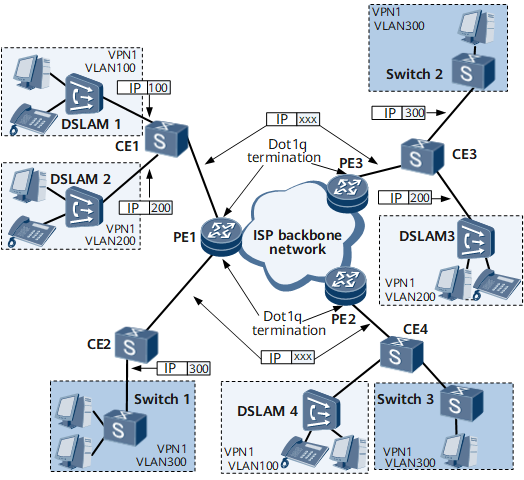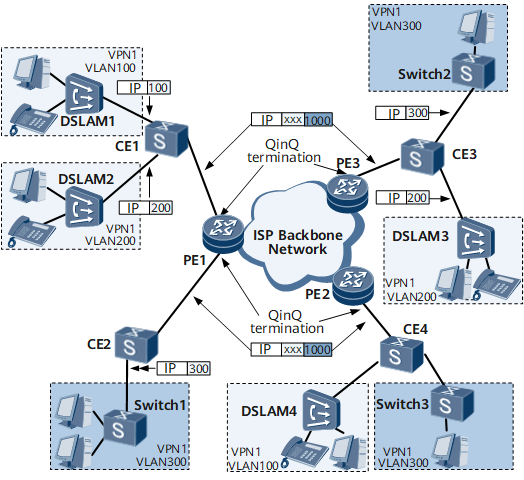L3VPN Access Through a Termination Sub-interface
On the network shown in Figure 1 and Figure 2, Layer 3 virtual private network (L3VPN) functions are configured on termination sub-interfaces.
L3VPN functions can be configured on a sub-interface for Dot1q VLAN tag termination or sub-interface for QinQ VLAN tag termination, based on whether the user packets received by a PE contain one or two VLAN tags.
If the user packets contain one tag, the sub-interface that has L3VPN functions configured is a sub-interface for Dot1q VLAN tag termination.
If the user packets contain double tags, the sub-interface that has L3VPN functions configured is a sub-interface for QinQ VLAN tag termination.
L3VPN Access Through a Sub-interface for Dot1q VLAN Tag Termination
Figure 1 shows a typical networking for L3VPN access through a sub-interface for Dot1q VLAN tag termination.
A user packet is attached with a customer-based VLAN tag on the Digital Subscriber Line Access Multiplexer (DSLAM) and then is transmitted transparently from the CE to the PE. On the PE, a sub-interface for Dot1q VLAN tag termination is configured, an outer VLAN tag is specified, and the sub-interface for Dot1q VLAN tag termination is bound to a VPN instance according to the outer VLAN tag.
After receiving the user packet, the PE strips off the outer VLAN tag and sends it to the L3VPN. At the same time, the PE needs to add a correct outer VLAN tag to the packet returned to the CE.
When the PE is terminating the outer tag of a user packet, ARP learning based on the outer VLAN tag of the user packet is required.
L3VPN Access Through a Sub-interface for QinQ VLAN Tag Termination
Figure 2 shows a typical networking for L3VPN access through a sub-interface for QinQ VLAN tag termination.
A user packet is attached with a customer-based VLAN tag on the DSLAM and then attached with a service-based VLAN tag on the CE. On the PE, the sub-interface for QinQ VLAN tag termination is configured, inner and outer VLAN tags are specified, and the sub-interface for QinQ VLAN tag termination is bound to a VPN instance according to double VLAN tags.
After receiving a QinQ packet from the user, the PE strips off double VLAN tags and then accesses the L3VPN. At the same time, the PE needs to add a correct outer VLAN tag and inner VLAN tag to the packet returned to the CE.
When the PE is terminating double tags of a user packet, ARP learning based on double VLAN tags of the user packet is required.

